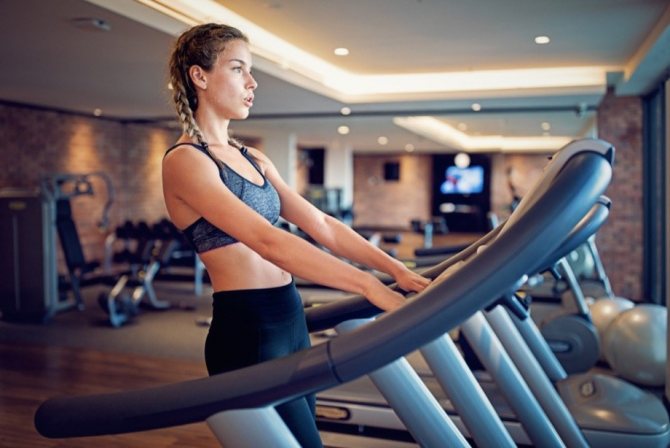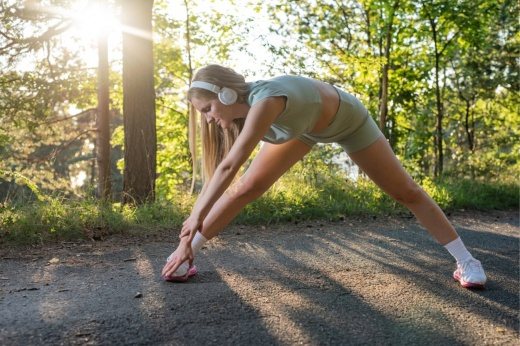The principle of working on a treadmill seems quite clear and simple to anyone: get up and go. Well, or ran. Depends on the level of training. A monotonous and rather long task, isn’t it? What if we look at this process from a slightly different angle and make small changes? This is what we will talk about now.
One of the options for diversifying activities on the track is a combination of aerobic and strength training.
Ekaterina Dyachenko
fitness trainer
Our task is to diversify cardio so that it is not boring and monotonous.
Circuit training
If you just get bored with running, you can give yourself a full-fledged circuit training session. In 40 minutes you will burn many more calories than if you just ran. The most important rule is not to rest!
Run
Duration:
10 minutes.
Photo: istockphoto.com
We run them at a pace that is comfortable for us, without raising our heart rate to the limit.
If you have problems with a 10-minute run, you can replace it with interval running. We walk calmly for two minutes and run for two minutes. In this case, aerobic exercise lasts the same 10 minutes, without changes.

Circuit training with expanders from the absolute world champion in bodybuilding
Squats
After cardio, we don’t rest and immediately go to the barbell.
- We place our legs shoulder-width apart, feet parallel to each other.
- We place the bar on our shoulders and bend our legs to a right angle, keeping our back straight.
- The head does not drop, the gaze is in front of oneself. We work with a weight that is difficult for 10 repetitions.
We perform squats 10 times.

Photo: istockphoto.com
Treadmill training programs
If you think that treadmill training is limited to walking or jogging, you are sorely mistaken. Find out what variety of exercises and workouts this machine can give you.
There are many fitness methods for getting rid of extra pounds, but opinions agree on one thing: a treadmill for losing weight is the most effective means, of course, subject to a well-designed training program.
Benefits of a treadmill
Training on a treadmill has a healing effect on the entire body: your blood pressure is normalized, the functioning of the cardiovascular and respiratory systems improves, and bones are strengthened. This aerobic exercise, which is running, develops your endurance. You saturate the entire circulatory system with oxygen, increasing muscle tone. And all this in addition to the fat-burning effect. On average, calorie consumption on a treadmill is 600-700 kcal/hour. This number may vary depending on the intensity of your workout.
Researchers from King's College London have found that exercise that strengthens leg muscles can improve cognitive performance in older adults over the long term. In a study of 324 healthy twin sisters followed for 10 years, researchers found that leg exercise slowed the rate of brain aging, which was a protective factor against Alzheimer's disease.
How to run correctly
Running technique. While doing exercises on the treadmill, your shoulders and chest should be straightened and your abs tense. The arms are also included in the work: they are bent at the elbows at a right angle and act in the opposite direction, which increases blood flow. Move smoothly, gradually increasing the pace from slow to fast. Read more: running technique.
Breath. Breathe deeply through your nose.
Best time to train. The debate about whether it is healthier to run in the mornings or evenings has been raging for a long time. If you have time in the morning, start the day with a cold or contrast shower and a run on the treadmill. This will energize you for the long day and will rev up your metabolism to earn carbs for breakfast. An evening run will allow you to relieve stress and calm your mind, in addition to all the other effects of running. Whatever time you choose to exercise on the treadmill, it is definitely healthier than lying on the couch.
Heart rate zone for fat burning To calculate the effective heart rate zone for an adult, during exercise in which the muscles work and the fat burning process occurs, use a special formula:
“220 minus (number of years)” or “200 minus (years after 20 years)”
Once you've calculated your maximum heart rate for your age (if you're 40, it's 180 beats per minute), you can determine your effective zone. In this example, this is 65 - 85% of the maximum, that is, from 180x0.65 to 180x0.85 = 117-153. It is better for you not to cross the boundaries of this zone: if the pulse is higher, there is a risk of overload, if lower, the effect of training on the treadmill will be minimal. Remember your effective heart rate and try to stay within its limits during cardio. But be careful: If you're 40 and this is your first cardio workout since college football, choose a gentler regimen.
Duration of training Due to the physiological characteristics of the body, it is important that your training is long enough. You can exercise with a heart rate slightly below the effective zone, but in this case your training on the treadmill should be longer by 20-30 minutes, ideally from 40 minutes to 1 hour. The optimal amount of training on a treadmill is 3 times a week. If you exercise more often, the body simply will not have time to recover and such loads will not bring benefits. And a weight loss program consisting of 1-2 workouts per week is practically useless (unless you supplement it with strength training).
Treadmill exercises Walking
It has an almost miraculous effect. In addition to accelerating the fat burning process, walking can relieve tension while simultaneously working all muscles. A minimum of 30 minutes of vigorous walking a day, either outside or on a treadmill, will help you maintain cardiovascular and respiratory health.
Run
The benefits of running on a treadmill are literally legendary. This type of cardio is the most popular, and is truly addictive - in the good sense of the word. If the first runs may give you mixed feelings of reluctance and laziness, then over time running training will be a joy.
Sprint
Allows you to get the most out of your potential. This type of treadmill workout requires you to push yourself to the limit, but also burns calories at full capacity.
Inclined
This is the easiest way to make your workout more challenging. By changing the incline angle, you contribute to even faster weight loss during workouts on the treadmill. Today, a method based on alternating walking at an incline and walking at a certain speed is increasingly gaining popularity in the niche of cardio training. And for good reason: regular exercise of this type really allows you to get your figure into the desired shape in a short time.
Speed
The main enemy of training effectiveness is monotony. There is only one way to avoid tedious exercise - by turning your treadmill workout into a game of speed. By alternating between jogging and walking, or walking and running at top speed, you'll get more fun and better results from your treadmill workout.
Interval training on the treadmill
If you accept the rules of the speed game mentioned above and include alternating rest and acceleration in your workouts, you can lose weight many times faster. This type of training is called interval training, it is distinguished by the duration of the intervals: limited in time or lasting as long as you have the strength.
Clearly timed intervals in training on a treadmill can be different, for example, 1 minute of sprint, 2 minutes of recovery, or 4 minutes of intense running with an incline, rest - 7 minutes. Planning for such an interval cardio workout on a treadmill depends on your physical fitness and cardiovascular health.
Interval training on a treadmill that does not have clear intervals is called “fartlek”, from the Swedish fartlek - “speed game”. This type of training involves running at full strength until failure, to use bodybuilding terminology. Once your strength is gone, take a recovery break, walk, and then run again at top speed. The most important thing for weight loss in this type of training on the treadmill is to work at your limit during the speed segment. Give it your all, stopping only when you no longer have the strength.
Whichever treadmill interval training program you choose, you'll notice results soon: it's been proven that calories continue to be burned even after the workout ends. set of exercises on a treadmill
Treadmill workout
Choose your level
Beginners: You should be prepared to do aerobic training for at least 3 months. Spend at least 2-4 weeks on endurance training, and only then move on to interval training.
Continued: You are in this group if you have been doing aerobic exercise at least 3 times a week for 3 months or more.
Advanced: You can focus on the level of requirements for this group if you have been doing aerobic training 4-5 times a week for at least 6 months.
All workouts should begin with a warm-up - 5 minutes of low-intensity cardio exercises: leisurely jogging around the gym or exercises on cardio equipment. The same amount of time should be allocated to complete the workout for the cool down. Cardiac activity should be changed gradually, the most harmful thing for our heart is not only the rapid onset of intense long-term exercise, but also its abrupt cessation.
Choose an aerobic intensity level that allows you to maintain a steady heart rate throughout your workout.
The principle of training
Every two weeks for beginners and intermediates, you can either increase the intensity of your workout or increase your workout time by 5%.
Most importantly, do not increase the intensity and duration of your workout at the same time!
The proposed cardio training program on a treadmill is designed for 30 minutes and consists of a warm-up, a uniform load, buttock training and a tempo part.
Warm-up
- Duration – 5 minutes
- Running speed – 5-6.5 km/hour
- Slope – 0%
Start your workout at the lowest speed. After two minutes, increase the speed by 0.3 km/h every 30 seconds. Gradually increase your speed to 5.5 km/h.
From time to time you can rise on your toes, holding the handrails, then walk on your heels for a few seconds. This is necessary to prepare the lower leg for walking uphill.
Try to stretch your arms and upper torso as well.
Uniform load
- Duration – 10 minutes
- Speed – 6.5 km/h
- Slope – 1%
Gradually increase your speed by 0.3 km/h until you are running.
At this point, those who prefer walking should reduce their speed by 1 km/hour, and those who prefer running should increase their speed by 1 km/hour.
Drive at this operating speed for 5 minutes on a 1% incline.
Then increase the incline to 3%, and for 5 minutes, increase the incline by 1% every minute thereafter, up to a total of 8%.
Strengthening the buttocks
- Duration – 10 minutes
- Working speed
- Slope varies
Reduce the slope to 2%. Walk or run at a working speed for 1-2 minutes. After this, walk or run at maximum speed, and then for 1 minute reduce the speed by 1-2 km/h.
Repeat the intervals twice. Increase the incline to 12% and begin brisk walking at a steady speed for 3-4 minutes. Repeat intervals and moving uphill.
Tempo part
- Duration – 5 minutes
- Speed - working
- Slope – 2%
Reduce the incline to 2% and run or walk at your running speed for 4 minutes. Then reduce the incline to 0% and gradually slow down to lower your heart rate.
Don't forget a water bottle and a towel. Guide yourself - 50 ml every 10 minutes.
Goal: make your legs beautiful
Choose between hills and rough terrain programs on the track. In “hills,” ascents alternate with movement in a straight line (this task is more difficult), and in “rough terrain,” with descents. If you are not very hardy yet, it is better to choose this one. But just don’t try to alternate walking uphill with running in a straight line. This is an unfortunate option: an experienced athlete rests while running in a straight line, but for beginners, both running and walking uphill is a considerable load. In this case, it is better to reserve only one of the running sessions per week for “hills”.
It is better to line up the “hills” as follows (by slope in percentage): 1-3-1-5-1-7-1-5-1-3-1. Run at your average pace, uphill for 1 minute, straight for 40 seconds. Don't forget about the cool-down and warm-up: 7-10 minutes of easy running at the beginning and end of the workout.
Goal: develop speed qualities
After 5-7 minutes of easy warm-up running, begin to accelerate. “To learn to develop higher speed, do a 25-second jerk, trying to give your best,” advises Evgeniy. - Then go to a slow run or vigorous walk and recover for 2-3 minutes. Make another throw, rest again. Repeat two times or more. How much exactly - decide based on your well-being (as soon as you realize that you are too tired for the jerk, stop) and time - interval training should not be longer than 20-30 minutes.”
To develop speed endurance (after all, our task is not just to rush to the finish line, but also to reach it), accelerate to a heart rate of 80-90% of the maximum and try to maintain the pace for 40-50 seconds. Then rest for 3-5 minutes.
Goal: lose weight by 5 kg
The figure in this case is very arbitrary: in three months you can lose one or eight kilos, depending on your initial weight (very obese people lose weight faster), nutrition and the amount of training. The treadmill offers two paths to a slim figure.
- The first is long, 40-60 minutes, training at a moderate pace (heart rate - 60-70% of maximum). Light running or walking, which is more suitable for obese people, can be practiced at least daily or even twice a day. For the muscles, this is not such a serious load that a day of rest is required after it.
- The second way is interval training. The intervals here will be different than with speed training. Try starting with one-minute bursts of acceleration, alternating them with a three-minute rest - running at a moderate pace. The task can be gradually made more difficult by increasing speed intervals and reducing recovery time: first to a ratio of 1:1, then to 2:1. It's important not to overwork yourself. Since interval training can lead to overtraining, you need to alternate it with others and apply it: we give it our all for two or three weeks, then take a break.
Remember that diet is the main contributor to fat loss.
Treadmill Exercises
If you are already tired of circuit training or running and squats are not enough, these exercises are definitely suitable. All you need is fitness bands. On the track, choose the lowest speed.
Walking sideways
Technique:
- We put the elastic band on the middle of the thighs and stand sideways to the treadmill control panel.
- We set the speed to low.
- We move with side steps in a half-squat, trying to ensure that the elastic band always remains in tension. Small steps, straight back, hands at the chin.
We walk for a minute on each side.

Photo: istockphoto.com
Lunges with a swing back
Technique:
- The elastic band clasps both thighs in the middle, we stand facing the control panel.
- The track speed is low. We lunge with one leg, after which we straighten the supporting leg and bring back the one that just lunged.
- We repeat the same with the second leg - lunge and swing back. The swing is made quickly and not very high. We keep an eye on the balance. You can lean on the special handrails of the walkway.
We walk like this for about 1-2 minutes.
Walking like a penguin
Technique:
- Elastic band on the hips.
- We set the average speed level on the track and go.
- The feet are shoulder-width apart and do not allow the tension in the elastic band to weaken, the toes are slightly turned to the sides. We try to use our buttocks when walking.
We walk like this for about 2-5 minutes.

TRX exercises to strengthen your deep core muscles. Back health depends on them

What happens if you don't warm up before training?
MAGAZINE Preschooler.RF
Summary of educational activities in the middle group “Walk along the path of health.”Tasks:
- teach children to take care of their health
- explain the importance of vitamins for humans, introduce vitamins A, B, C, D
- consolidate basic concepts: “personal hygiene” , “vitamins” , “healthy products”
- develop children's ability to answer questions
- develop thinking, memory
- develop an interest in personal hygiene items
- develop an interest in a healthy lifestyle
- create a positive emotional mood
Material: flowers, wood with toothbrush, toothpaste, soap, towel, comb; illustration of happy and sad teeth; dummies of vegetables, fruits, sweets; audio recording of nature sounds.
Progress of the lesson:
Educator: Guys, we have a guest today
He wears a Jolly Cap instead of a hat. And he is only as tall as a child's shoe.
With a flashlight and a song, he walks through the forest at night. You won't be wrong if you say:
- This is... (gnome)
Dwarf:
- Hello guys! (children greet the gnome) My name is the big gnome. Today is beautiful weather and I want to invite you to take a walk in my fairy forest.
Educator:
“And you know that we don’t just say hello, but wish each other health.”
“Hello” - I wish you good health.
Guys, what does it mean to be healthy? (children's answers)
Dwarf:
- Well done, are you willing to go with me along the “path of health” ?
Go for a walk!
Let's not yawn! Pull yourself up!
(music sounds - sounds of nature)
- Flower glade
- Guys, what do you see in the clearing? (grass, a lot of flowers) And when there are a lot of flowers, then it’s a whole... (flower meadow).
What can you tell us about the colors you see? Yes, that’s right, flowers of different colors bloomed in our meadow. What colors can you name? (children's answers)
You can pick one flower for yourself, but with one condition: the color of the flower matches your mood. (children choose their own flowers)
I am very glad that everyone picked bright flowers. It means you're in a good mood! But sometimes people’s moods change. What do you think causes mood changes?
When are you in a good mood? When is it bad? (children's answers)
That's right, if everything is fine with a person, he is healthy, then he is in a good mood. But if there are some troubles or a person is sick, then the mood is bad.
What can you do to cheer yourself or your friend up? (children's answers). You can also do some fun exercises!
The sun looked into the crib, One, two, three, four, five. We all do exercises, We need to sit down and stand up.
Stretch your arms wider, One, two, three, four, five. Bend over - three, four. And jump on the spot.
On the toe, then on the heel. We all do exercises.
Well done! Now let’s continue our walk in a good mood!
- "Tasty" meadow.
(sounds of nature)
- Guys, look, we have come to a new clearing. What do you see here? (products). This unusual clearing can be called... (children offer their own options)
Do you know that in order to be healthy you need to eat right!?
Didactic game “Harmful - Useful” .
(children go out one by one and lay out the products, on the table with a cheerful cryptogram - healthy products, with a sad one - “harmful” products)
Look, there are fruits and vegetables on the table with the cheerful little man. What is so useful about them? (vitamins)
That's right, to be healthy, you need to eat more vegetables and fruits, which contain many vitamins. I suggest you all listen to poems about vitamins.
I am vitamin A It’s easy to remember me You will find me in carrots I am vitamin growth.
They called it Vitamin B. They strictly said: Live in nuts, cucumbers, Bread, sorrel, mushrooms.
Even though I taste sour Smile, Sonya... I’m called Vitamin C And I live in a lemon.
We lay in the sun and took Vitamin D. Who are we now: guys or just chocolates?
Let's remember what vitamins you know? (AVSD) Vitamin A is needed for growth, for strong teeth, vitamin B - for appetite, good mood, vitamin C - for health, vigor.
Look at our products, and together with me we will try to name what vitamins they contain. (children take food from the baskets and name the vitamins they contain)
I never lose heart and have a smile on my face, Because I take Vitamins A, B, C.
Why did you put the sweets in the basket with the sad man, because they are very tasty? (children's answers about the dangers of sweets for teeth.)
- Clearing with a tree.
Guys, look at what an interesting miracle tree is growing. And some interesting fruits grow on it! But to find out what grows on this tree, we need to solve riddles. (pictures – turn over answers after children’s correct answers)
It slips away like something alive, but I won’t let it go. It foams with white foam, I’m not too lazy to wash my hands. (soap)
Elastic band - Akulinka Went for a walk on the back. And while she was walking, her back became pink. (bast)
Waffle and striped, Smooth and shaggy, Always at hand - What is it? (towel)
Bone back, Stiff bristles, Friendly with toothpaste, Serves us diligently. (Toothbrush)
He has a lot of teeth, but he doesn't eat anything. (comb)
Well done! Guys, have you ever met such unusual trees? What is growing on this tree? What are these items needed for? (for personal hygiene)
What is soap used for? When do we wash our hands? (We wash our hands before eating, after a walk, when our hands get dirty after drawing or modeling, after petting animals, because there are a lot of germs on their fur)
What is a towel for? What is a comb for? (answers)
What is a toothbrush for? How many times a day do you brush your teeth?
Guys, there is one important rule that you must remember!
“Everyone should have their own hygiene items!”
Look under our tree there is something. (basket)
There are 2 teeth (pictures) in the basket – a happy one and a sad one. Why do you think one is cheerful and the other is sad? (children's answers) What needs to be done to make the 2nd tooth happy? (brush your teeth 2 times a day, rinse your mouth after eating, go to the dentist for checkups, eat less sweets)
Our journey ends, but the gnome has prepared one more task for us. The big guy is very cunning, be careful!
Assignment from the gnome
- Listen carefully, and tell me whether you need to do this to be healthy or not.
1. To grow and harden, you need to play sports.
2. Let you not be too lazy to brush your teeth 2 times a day.
3. To prevent your teeth from hurting, eat caramel candies.
4. If you go out for a walk in winter, you should leave your hat and scarf at home.
5. Fruits and vegetables before meals Wash thoroughly, very diligently.
6. Here’s another simple tip: Wash your hands before eating.
7. Run away from your mother quickly. Don’t let her cut your nails.
8. Handkerchief and comb must be your own. Remember this and do not use someone else’s.
9. If there is a puddle or mud on the street, you should definitely fall into it.
Well done, you answered correctly. (the gnome praises the children)
I wish you guys to always be healthy, but achieving results is impossible without difficulty.
Try not to be lazy: Before sitting down at the table, wash your hands with soap and water. And do exercises
Every morning. And, of course, toughen up - this will help you so much! Breathe fresh air
Always whenever possible. Go for walks in the forest - He will give you strength, friends! Goodbye!
Educator:
-Now we can return from our walk. Did you like it? What's your mood? (children's answers)
| Next > |










